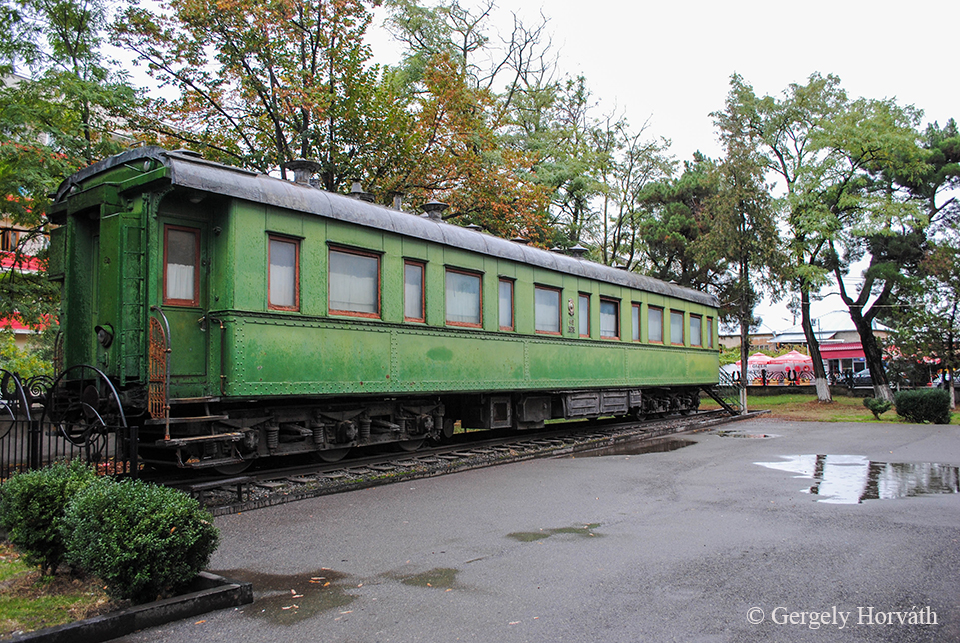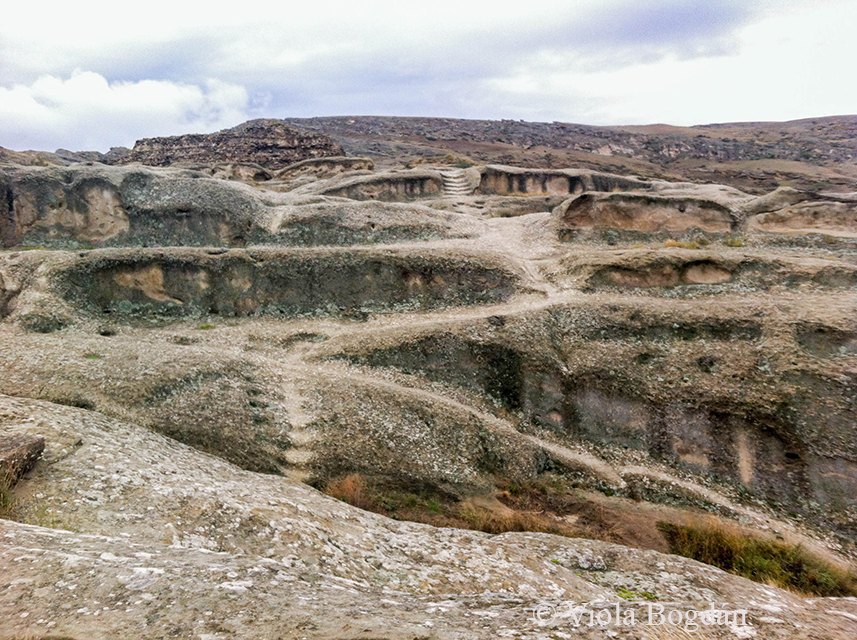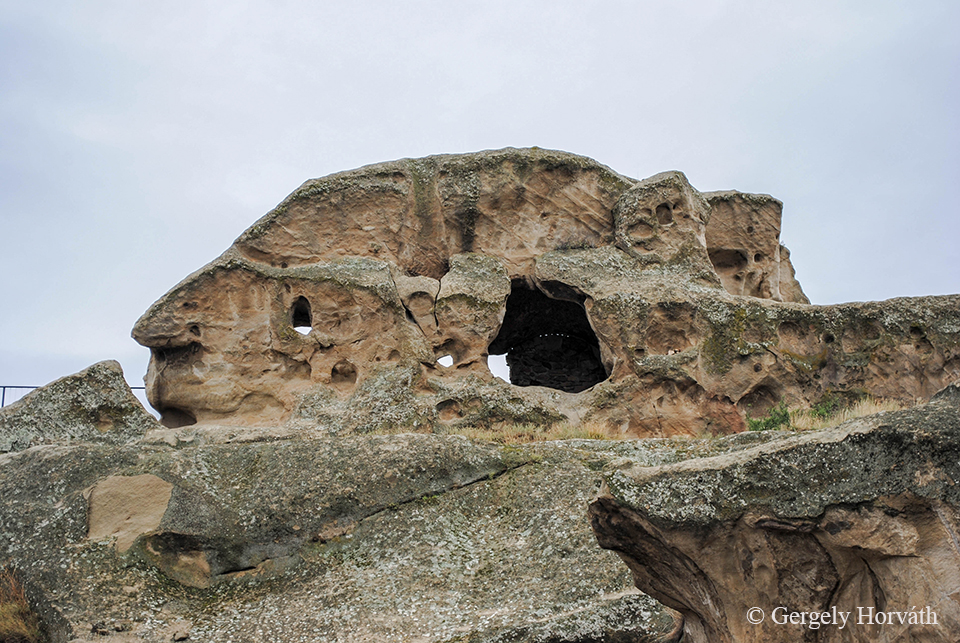A Tbiliszitől mintegy órás autóútnyira keletre található Gori első látásra nem tűnik túl jelentős városnak, már csak méretéből adódóan sem, hiszen alig 55 ezer fő lakja. Ám mivel kereskedelmi szempontból fontos útvonal mentén fekszik, történelme mozgalmasabb, mint gondolnánk, mindenképpen érdemes útba ejteni.
Gori lies cca. one-hour drive east from Tbilisi. The medium size town (almost 55.000 inhabitants) looks like a not so important, calm and sleepy place at first, but as it's located along an important trading route its history was far more eventfull than you might think. It's definetely worth to make a short visit here.

A várost a hagyomány szerint Építő Dávid által itt letelepített örmények alapították a 11. században, de a Gori erőd (Gorisz Cike) már jóval korábban (7. sz.) felépült a környék fölé magasodó dombra, mivel a kulcsfontosságú, kelet-nyugat irányú kereskedelmi útvonal (ma autópálya) itt halad keresztül. Ennél a ténynél fogva Gori birtoklása mindig is nagy stratégiai jelentőséggel bírt és a történelem során többször cserélt gazdát. Legutóbb 2008-ban, mikor a orosz-grúz háború során orosz-oszét csapatok egy hétig tartották megszállás alatt.
According to the chronicles, the town was founded during the 11th century by David the Builder wo settled armenians here. However, the Gori Fortress (Goris Tsikhe) dates back to the 7th century. As the East-West trading route (nowadays motorway) passes near the town, possessing Gori always had a considerable strategic potencial and hence changed its masters several times. Last time in 2008 when the town was occupied by russian-ossetian forces for a week during the South Ossetian War.

A 2008-as háború során az orosz légicsapások és tüzérségi támadások jelentős pusztítást okoztak a városban, ám ebből ma már szinte semmit sem érezni. Bár a háború végén kijelölt dél-oszét demarkációs vonal fenyegetően közel található, Gori lakosai élik életüket és természetesen, ahol lehet, szőlőt, bort is termelnek.
The war in 2008 was devastating for Gori as the russian army bombed and shelled the local Georgian military base causing several damages in civilian buildings as well. However, today you can feel almost nothing of this recent events. Although the South-Ossetian demarcation line is threateningly close, local people lives their lives and off course raising grapes and producing wine wherever they can.

Az orosz-grúz háborús eseményen kívül Gori még egy dologról híres, de arról nagyon és ez elég kétes hírnév. 1878 december 18-án itt látta meg a világot egy Jozeb Beszarionisz dze Dzsugasvili nevezetű grúz fiúcska, aki felnőve egy rövid, a tbiliszi papi szemináriumban eltöltött kitérő után illegális kommunistából a fél világot markában tartó diktátorrá emelkedett, Joszif Sztálin néven. Nehéz lehet megküzdeni a ténnyel, hogy a város (horribile dictu az ország) legismertebb szülötte egyben a világ legnagyobb tömeggyilkosa is, de Goriban minden politikai akarat és szándék ellenére a mai napig Sztálin sugárútnak hívják a város főútját ezen kívül múzeuma is van Joszifnak, és bár hatalmas bronzszobrát a városháza térről már eltávolították (állítólag nemsokára visszahelyezik) emléke a mai napig elevenen él és évente turisták ezreit vonzza a városba.
Besides its short term role during the South-Ossetain War Gori's fame comes from one particualarry dubious person. On the 18th December 1878 a boy named Ioseb Besarionis dze Jughashvili was born here, who, after a short period in Tiflis Spritiual Seminary, from underground communist became the almighty dictator of the half of the globe under the name Joseph Stalin. It should be hard to deal with the fact that the most famous son of the town (horrible dictu the whole country) is the biggest mass-murderer of the world, but despite every political effort the main avenue in Gori is still named after Stalin and there is a musem dedicated to him as well. Although his bronze statue was removed from the city centre (according to various sources they are planning to re-erect it) the memory of the soviet dictator is very vivid in his birthtown attracting annually several thousands of tourists to Gori.

A Sztálin Múzeum épülete.
The Stalin Museum.

A múzeumhoz tartozik Sztálin (állítólagos) szülői háza is.
Stalin's (alleged) birth-house is part of the museum.



Sztálin személyes páncélvagonja is ki van állítva, melyet 1941-től használt rendszeresen, külföldi (ezzel érkezett például a Jaltai és Teheráni konferenciára) és belföldi utakra egyaránt. A repüléstől állítólag nagyon félt, autózni meg nem szeretett.
Stalin's personal armoured carriage. He travelled on this railway carriage from 1941 onwards to abroad (e.g Yalta and Tehran Conference) and inland. According to rumors he was frightened to flight and did not like cars.
Biztos akad olyan, akinek már csak a Sztálin Múzeum is elég a látványosságok közül, de van még legalább egy nevezetes hely, amit kár kihagyni. Igaz, hogy ez nem Goriban található, de a fél óra buszozás és pár perces gyaloglás szerintem senkinek sem lehet kifogás, úgyhogy ha Goriban jártok, akkor Upliszcikét mindenképp kötelező felkeresni.
I'm sure that for some people the Stalin Museum is more than enough must-see, however there is at least one more landmark what would be a pity to miss. Okay, it's not in Gori, you have to take a bus there, but it's only half an hour from your life and a short walk could not be an excuse either, so it is mandatory to visit Uplistsikhe.

Upliszcike történelmi értékét az a tény adja, hogy ez Grúzia legősibb, huzamosabb ideig lakott települése. Ráadásként sziklavárosról van szó, melyet teljes egészében a Kura (Mtkvari) bal partján magasodó sziklákba vájt épületekből, termekből alakítottak ki.
The historical significance of Uplistsikhe comes from the fact that this is the oldest urban settlement in Georgia. Moreover it is a rock-hewn city built on the high-rocky left bank of the Kura (Mtkvari) River.

Az egykori város a kora vaskortól kezdve lakták és csak a középkor legvégén néptelenedett el. Mivel a valaha itt létezett ősi királyságok szívében található, hadászatilag fontos erődítményként szolgált az ókortól kezdve. Nagy Sándor biztosan megütközött a területet uraló "harcias törzsekkel" de a későbbi hódítók dolgát is nagyban megnehezítették a nehezen bevehető város lehetőségeit kihasználó, ide visszavonuló helyi hadak. Az évezredek folytán Upliszcikét folyamatosan új "épületekkel" egészítették ki, az egyes korokra jellemző építészeti struktúrák pedig jól elkülöníthetőek egymástól.
The onetime settlement was inhabitet from the Early Iron Age till the Late Medieval Period. It is located in the heartland of the ancient kingdoms once existed here (e.g. Kartli) and was a strategically important strongold for many occasions. Alexander the Great surely engaged a battle with the 'militant tribes' of this area but later conquerors had a hard time to overcome the defenders of the hardly pregnable city as well. During the millenias Uplistsikhe was expanded with new 'buildings' and the various structures of different eras are easily recognizeable.


Upliszcike igen fontos vallási központ volt, ahol a rítusok főleg a szőlőhöz, borhoz és gabonához kötődtek. A kereszténység felvétele után jelentősége csökkent, de egyes források szerint a város elnéptelenedésig végeztek itt pogány szertartásokat.
Uplistsikhe was the main regional hub of ancient Georgia where worships involved mainly the gifts of nature: grapes, wine and grain. Its importance declined after adoptation of christianity, however, according to various sources pagan beliefs survived for a long time and sacrifices were presented till the very depopulation of the city.


A város keresztény templomát a 9.-10. század fordulóján emelték a pogány templom fölé.
This christian church was built in the 9/10 century over the ancient temple.


A híres "arc" szikla
The famous 'profile' rock


A Kura (Mtkvari) Tbilisziből már ismerős.
The Kura River (Mtkvari) is familiar from Tbilisi.




A táj természetesen festői.
The landscape is of course marvelous.



Gorit és Upliszcikét elhagyva utunk utolsó állomására, Batumiba indultunk tovább, ahová nem kevésbé kalandos módon sikerült eljutnunk, de erről majd a következő, záró bejegyzésben lesz szó.
After Gori and Uplistsikhe we travelled to our last destination Batumi, where we managed to get on a quite adventurous way. But this I will tell about in my next, closing post.